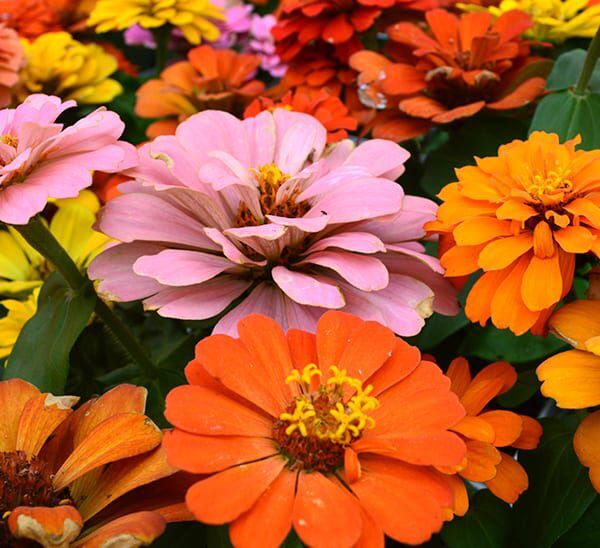Zinnia
Zinnia flowers are prolific bloomers that love the sun! Great in landscapes and containers for bursts of color.
Mixed Colors Available.
Color may vary from images shown, depending on available store inventory.
Please contact your local store for product availability.
Find a garden center near you.
Species: Zinnia Hybrid
Plant Height: 14-16 in.
Spread: 16-18 in.
Minimum Sunlight: Full Sun
Maximum Sunlight: Full Sun
Zinnias produce daisy-like blooms from mid-spring through summer. Heat and drought tolerant, the plant is great for containers or as a cut flower in arrangements.
Zinnias are an upright annual that works well in containers, hanging baskets, borders, and flowerbeds. A low-maintenance bloom that is heat tolerant.
Zinnias will grow between 14-16 inches tall and spread out to 18 inches. A fast-growing bloom that enjoys the sun, making this great for sunny landscapes. Dense green foliage allows this plant to compliment other blooms well in containers and flowerbeds.
Frequently Asked Questions
Zinnias thrive in full sun, requiring at least 6–8 hours of direct sunlight daily. Ample sunlight encourages strong stems, vibrant blooms, and resistance to mildew. While they can tolerate light shade, too little sun may lead to weak growth and fewer flowers.
Zinnias prefer well-draining, fertile soil with a slightly acidic to neutral pH (6.0–7.5). They grow well in loamy or sandy soil enriched with organic matter. Avoid heavy clay or waterlogged soil, as poor drainage can lead to root rot and fungal issues.
Keep the soil moderately moist but never soggy. Water deeply once or twice a week, allowing the top inch of soil to dry between waterings. Established Zinnias are somewhat drought-tolerant. Avoid overhead watering—wet leaves can lead to powdery mildew.
Feed Zinnias with a balanced, all-purpose fertilizer (10-10-10) every 4–6 weeks during the growing season. Too much nitrogen can cause lush foliage with fewer blooms, so moderate feeding is best. Mixing compost into the soil at planting also provides lasting nutrients.
Regular pruning keeps Zinnias full and blooming. Pinch back the tips of young plants to encourage branching, and deadhead spent flowers to extend the blooming period. Cutting mature blooms for arrangements also promotes new flower growth.
Zinnias can attract aphids, spider mites, and whiteflies, especially in dry conditions. Powdery mildew and leaf spot may occur in humid or crowded plantings. Provide good air circulation, water at the base, and remove infected leaves promptly.
Watch for aphids, spider mites, and whiteflies. Treat infestations with neem oil or insecticidal soap. Zinnias are prone to powdery mildew, especially in humid conditions—ensure good spacing and water at the base to help prevent it.
No—Zinnias are not frost-tolerant. They thrive in warm weather and should be planted after the last frost when soil temperatures reach at least 60°F. Frost or cold snaps will quickly damage or kill the plants.
